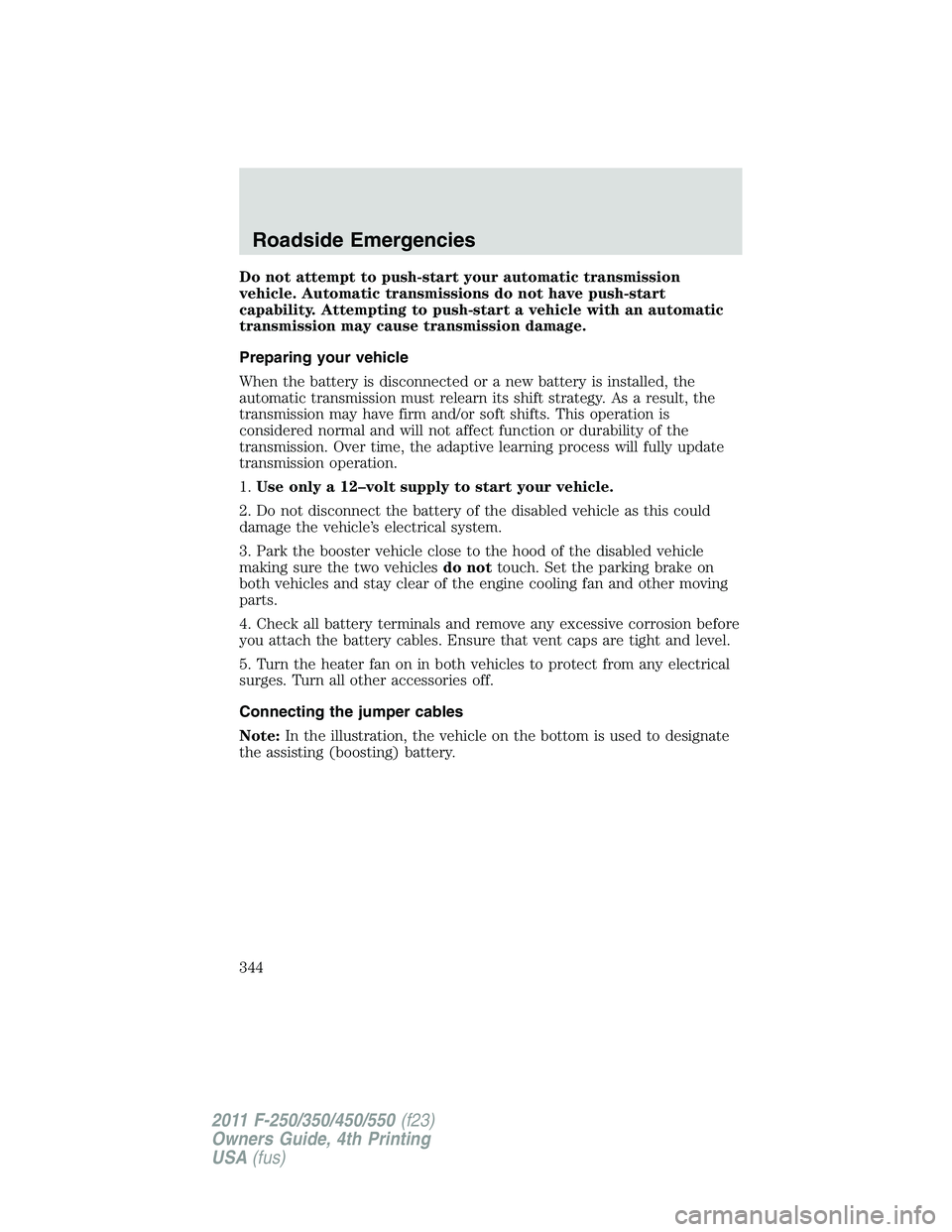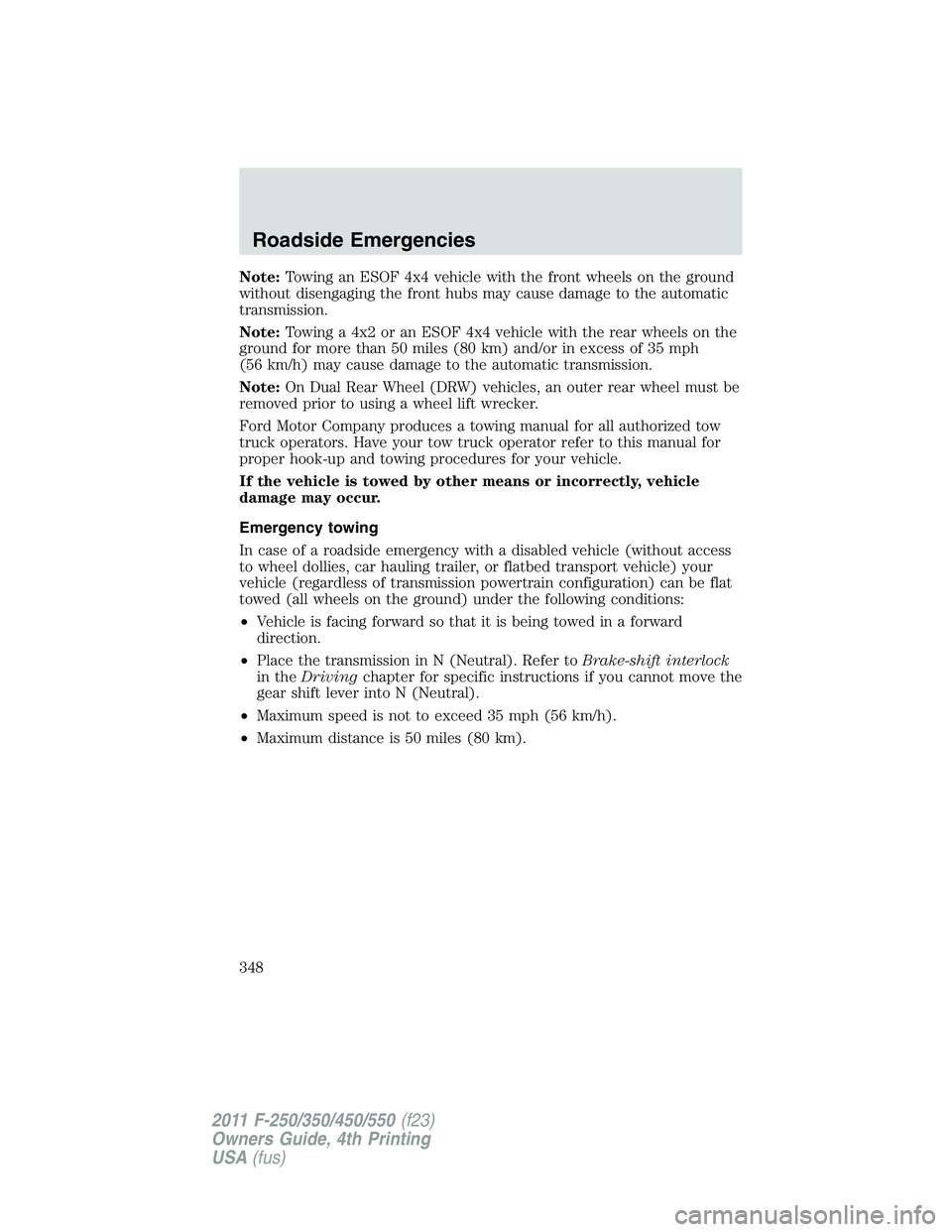Page 344 of 449

Do not attempt to push-start your automatic transmission
vehicle. Automatic transmissions do not have push-start
capability. Attempting to push-start a vehicle with an automatic
transmission may cause transmission damage.
Preparing your vehicle
When the battery is disconnected or a new battery is installed, the
automatic transmission must relearn its shift strategy. As a result, the
transmission may have firm and/or soft shifts. This operation is
considered normal and will not affect function or durability of the
transmission. Over time, the adaptive learning process will fully update
transmission operation.
1. Use only a 12–volt supply to start your vehicle.
2. Do not disconnect the battery of the disabled vehicle as this could
damage the vehicle’s electrical system.
3. Park the booster vehicle close to the hood of the disabled vehicle
making sure the two vehicles do not touch. Set the parking brake on
both vehicles and stay clear of the engine cooling fan and other moving
parts.
4. Check all battery terminals and remove any excessive corrosion before
you attach the battery cables. Ensure that vent caps are tight and level.
5. Turn the heater fan on in both vehicles to protect from any electrical
surges. Turn all other accessories off.
Connecting the jumper cables
Note: In the illustration, the vehicle on the bottom is used to designate
the assisting (boosting) battery.Roadside Emergencies
344
2011 F-250/350/450/550 (f23)
Owners Guide, 4th Printing
USA (fus)
Page 348 of 449

Note: Towing an ESOF 4x4 vehicle with the front wheels on the ground
without disengaging the front hubs may cause damage to the automatic
transmission.
Note: Towing a 4x2 or an ESOF 4x4 vehicle with the rear wheels on the
ground for more than 50 miles (80 km) and/or in excess of 35 mph
(56 km/h) may cause damage to the automatic transmission.
Note: On Dual Rear Wheel (DRW) vehicles, an outer rear wheel must be
removed prior to using a wheel lift wrecker.
Ford Motor Company produces a towing manual for all authorized tow
truck operators. Have your tow truck operator refer to this manual for
proper hook-up and towing procedures for your vehicle.
If the vehicle is towed by other means or incorrectly, vehicle
damage may occur.
Emergency towing
In case of a roadside emergency with a disabled vehicle (without access
to wheel dollies, car hauling trailer, or flatbed transport vehicle) your
vehicle (regardless of transmission powertrain configuration) can be flat
towed (all wheels on the ground) under the following conditions:
• Vehicle is facing forward so that it is being towed in a forward
direction.
• Place the transmission in N (Neutral). Refer to Brake-shift interlock
in the Driving chapter for specific instructions if you cannot move the
gear shift lever into N (Neutral).
• Maximum speed is not to exceed 35 mph (56 km/h).
• Maximum distance is 50 miles (80 km).Roadside Emergencies
348
2011 F-250/350/450/550 (f23)
Owners Guide, 4th Printing
USA (fus)
Page 368 of 449
6.2L V8 gasoline engine
1. Windshield washer fluid reservoir
2. Engine oil dipstick
3. Automatic transmission fluid dipstick
4. Brake fluid reservoir
5. Engine coolant reservoir
6. Power distribution box
7. Air filter assembly
8. Power steering fluid reservoir
9. Engine oil filler cap
10. Battery 1 2 3 4 5 6
10
9
8 7Maintenance and Specifications
368
2011 F-250/350/450/550 (f23)
Owners Guide, 4th Printing
USA (fus)
Page 369 of 449
6.8L V10 gasoline engine
1. Windshield washer fluid reservoir
2. Battery
3. Automatic transmission fluid dipstick
4. Engine oil filler cap
5. Engine oil dipstick
6. Power steering fluid reservoir
7. Brake fluid reservoir
8. Engine coolant reservoir
9. Air filter assembly
10. Power distribution box 1 2
3 5
6 7
8 9 10
4
Maintenance and Specifications
369
2011 F-250/350/450/550 (f23)
Owners Guide, 4th Printing
USA (fus)
Page 396 of 449

BRAKE FLUID
• Vacuum boost system
• Hydroboost system
The fluid level will drop slowly as the brakes wear, and will rise when the
brake components are replaced. Fluid levels between the top of the MIN
and MAX lines are within the normal operating range; there is no need to
add fluid. If the fluid levels are outside of the normal operating range,
the performance of your brake system could be compromised; seek
service from your authorized dealer immediately.
TRANSMISSION FLUID
Checking automatic transmission fluid (if equipped)
Refer to your scheduled maintenance information for scheduled
intervals for fluid checks and changes. Your transmission does not
consume fluid. However, the fluid level should be checked if the
transmission is not working properly, i.e., if the transmission slips or
shifts slowly or if you notice some sign of fluid leakage.
Automatic transmission fluid expands when warmed. To obtain an
accurate fluid check, drive the vehicle until it is at normal operating
temperature (approximately 20 miles [30 km]). Verify that the
transmission fluid temperature gauge, located on the instrument cluster,
is within normal range.
1. Drive the vehicle 20 miles (30 km) or until it reaches normal operating
temperature. MINMAX
Maintenance and Specifications
396
2011 F-250/350/450/550 (f23)
Owners Guide, 4th Printing
USA (fus)
Page 399 of 449

Adjusting automatic transmission fluid levels
Before adding any fluid, make sure the correct type is used. The type of
fluid used is normally indicated on the dipstick handle and also in the
Maintenance product specifications and capacities section in this
chapter.
Use of a non-approved automatic transmission fluid may cause
internal transmission component damage.
If necessary, add fluid in 1/2 pint (250 ml) increments through the filler
tube until the level is correct.
Type A
Type B
If an overfill occurs, excess fluid should be removed by a qualified
technician.
An overfill condition of transmission fluid may cause shift and/or
engagement concerns and/or possible damage.
Do not use supplemental transmission fluid additives, treatments or
cleaning agents. The use of these materials may affect transmission
operation and result in damage to internal transmission components. ADD COLD HOT DO NOT ADD
Maintenance and Specifications
399
2011 F-250/350/450/550 (f23)
Owners Guide, 4th Printing
USA (fus)
Page 409 of 449
Item Capacity Ford part name Ford part number /
Ford specification
Hinges, latches, striker
plates, fuel filler door
hinge and seat tracks — Multi-Purpose Grease XG–4 or XL-5 /
ESB-M1C93–B
Lock cylinders — Motorcraft � Penetrating
and Lock Lubricant XL-1 / None
Transmission / parking
brake linkages and
pivots, brake pedal shift — Motorcraft � Premium
Long-Life Grease XG-1-C or XG-1-K /
WSD-M1C227-A
Power steering fluid Keep fluid level
between MIN and
MAX on reservoir Motorcraft �
MERCON � VATF XT-5-QM /
MERCON � V
Transfer case fluid 2.0 quarts (1.9L) Motorcraft � Transfer
Case Fluid XL-12 / —
Automatic transmission
fluid
(5–speed)
317.5 quarts
(16.6L)
4Motorcraft �
MERCON � LV AT F XT-10–QLV /
MERCON � LV
Automatic transmission
fluid
(6-speed)
318.5 quarts
(17.5L)
4, 616.7 quarts
(15.8L)
4, 7Maintenance and Specifications
409
2011 F-250/350/450/550 (f23)
Owners Guide, 4th Printing
USA (fus)
Page 410 of 449

Item Capacity Ford part name Ford part number /
Ford specification
Windshield washer fluid Fill as required Motorcraft � Premium
Windshield Washer
Concentrate (US)
Premium Quality
Windshield Washer Fluid
(Canada) ZC-32–A (US)
CXC-37-(A, B, D, and F)
(Canada) /
WSB-M8B16–A2 /- -
1Add 8 oz. (236 ml) of Additive Friction Modifier XL-3 or equivalent meeting Ford Specification
EST-M2C118–A for complete refill of limited slip Ford axles. Ford design rear axles contain a
synthetic lubricant that does not require changing unless the axle has been submerged in water.
2Add the coolant type originally equipped in your vehicle.
3Ensure the correct automatic transmission fluid is used. Transmission fluid requirements are
indicated on the dipstick blade or the dipstick handle. Check the container to verify the fluid being
added is of the correct type. Refer to your scheduled maintenance information to determine the
correct service interval.
Automatic transmissions that require MERCON � LV should only use MERCON � LV fluid.
Use of any fluid other than the recommended fluid may cause transmission damage.
4Indicates only approximate dry-fill capacity. Some applications may vary based on cooler size and
if equipped with an in-tank cooler. The amount of transmission fluid and fluid level should be set
by the indication on the dipstick’s normal operating range.
5Use of synthetic or synthetic blend motor oil is not mandatory. Engine oil need only meet the
requirements of Ford specification WSS-M2C930-A and the API Certification mark.
6Refer to Checking automatic transmission fluid in this chapter for the correct dipstick type.
Fill to the proper capacity according to dipstick Type A.
7Refer to Checking automatic transmission fluid in this chapter for the correct dipstick type.
Fill to the proper capacity according to dipstick Type B.Maintenance and Specifications
410
2011 F-250/350/450/550 (f23)
Owners Guide, 4th Printing
USA (fus)